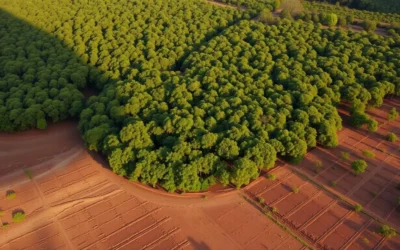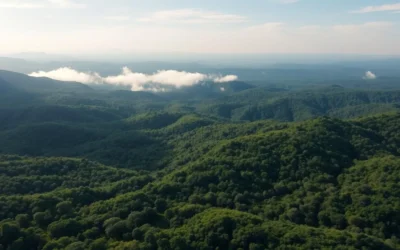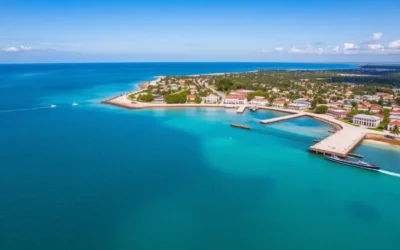Did you know that Sambava produces over 80% of Madagascar’s vanilla, making it the undisputed “Vanilla Capital of the World”? This charming coastal town on Madagascar’s northeastern shore offers travelers a unique blend of aromatic plantations, pristine beaches, and authentic cultural experiences far from the typical tourist path. As you walk through town, the sweet scent of sun-cured vanilla wafts through the air, creating an unforgettable sensory experience found nowhere else on earth.
Getting There & Planning Your Journey
Reaching Sambava requires some planning, as it’s located in a remote part of Madagascar’s northeastern coast. Most international travelers arrive at Antananarivo’s Ivato International Airport before connecting to the region.
By Air
The most convenient way to reach Sambava is by air. Madagascar Airlines operates flights from Antananarivo to Sambava Airport several times weekly. Flight time is approximately 2 hours. Schedules can change seasonally, so it’s advisable to book well in advance.
Book your Flights early, as seats on domestic routes fill quickly, especially during high season (May-October).
By Road
For the adventurous traveler, reaching Sambava by road is possible but challenging. Taxi-brousse (shared taxi vans) connect major cities, though the journey from Antananarivo takes 2-3 days with overnight stops. The roads can be difficult, particularly during the rainy season.
Consider Rental Cars with a driver in Antananarivo if you prefer more flexibility, though be prepared for rough road conditions.
Travel Tip: Arrange your transportation and accommodations before arriving in Sambava. Local travel agencies can help coordinate transfers from the airport to your hotel.
Best Time to Visit & Weather Tips
Sambava has a tropical climate with distinct wet and dry seasons that significantly impact your travel experience.

Dry Season (May to October)
The ideal time to visit Sambava Madagascar is during the dry season when temperatures average 20-28°C (68-82°F). This period offers comfortable weather for exploring vanilla plantations, beaches, and nearby natural attractions.
July and August are particularly popular for tourists, with clear skies and minimal rainfall. This is also when vanilla harvesting begins, making it an excellent time to witness this fascinating process.
Rainy Season (November to April)
The rainy season brings heavy precipitation and potential cyclones, especially between January and March. Travel during this time can be challenging due to flooded roads and limited accessibility to certain areas.
If you do visit during the rainy season, plan indoor activities and be prepared for schedule changes. Some accommodations offer reduced rates during this period.
Weather Alert: Cyclone season typically peaks between January and March. If traveling during these months, monitor weather forecasts closely and have contingency plans in place.
Getting Around Locally
Navigating Sambava and its surroundings offers a glimpse into local life while accessing the region’s attractions.
Explore Sambava With Local Guides
Book guided tours to make the most of your visit to Sambava’s unique attractions.
Where to Stay
Sambava offers a range of accommodation options to suit different budgets and preferences, though luxury options are limited compared to more developed tourist destinations.

Budget Options
Several guesthouses in town offer basic but clean rooms starting from 40,000 Ariary (approximately $10 USD) per night. These typically include a fan and shared bathroom facilities.
Local homestays provide an authentic experience and opportunity to connect with residents, often including home-cooked meals featuring fresh vanilla and coconut dishes.
Mid-Range Hotels
Hotels like Melrose Sambava Hotel offer private rooms with en-suite bathrooms, air conditioning, and on-site restaurants. Prices range from 120,000-200,000 Ariary ($30-50 USD) per night.
These establishments often provide additional services such as airport transfers and tour arrangements to vanilla plantations and Marojejy National Park.
Beachfront Resorts
For a more comfortable stay, beachfront resorts on the outskirts of town offer bungalows with sea views, private terraces, and restaurant facilities. Expect to pay 250,000-400,000 Ariary ($60-100 USD) per night.
Many include breakfast featuring local fruits and vanilla-infused specialties, and can arrange excursions to nearby attractions.
Find Your Perfect Stay in Sambava
Book your accommodation in advance to secure the best options, especially during the high season (May-October).
Dining & Local Cuisine
Sambava’s culinary scene showcases the rich flavors of Madagascar’s northeast coast, with an emphasis on fresh seafood, tropical fruits, and vanilla-infused specialties.

Must-Try Local Dishes
Seafood Specialties
- Romazava: A traditional Malagasy stew made with seafood, greens, and ginger.
- Grilled Fish: Freshly caught fish served with coconut rice and local vegetables.
- Crab Curry: Local mud crabs prepared in a rich coconut sauce with Madagascar spices.
Vanilla-Infused Cuisine
- Vanilla Chicken: Tender chicken cooked with fresh vanilla pods and local herbs.
- Vanilla Rice Pudding: A sweet dessert highlighting the region’s famous spice.
- Vanilla Tea: A soothing beverage made with fresh vanilla and local herbs.
Dining Tip: When ordering seafood, ask what was caught that day for the freshest options. Most restaurants prepare dishes to order, so be prepared to wait a bit longer for your meal.
Attractions, Sightseeing & Activities
Sambava offers a diverse range of attractions that showcase its natural beauty, cultural heritage, and economic significance as Madagascar’s vanilla hub.
Vanilla Plantations

No visit to Sambava is complete without touring a vanilla plantation. Learn about the labor-intensive cultivation process, including hand-pollination of the vanilla orchids.
Many plantations offer guided tours where you can see the entire process from flowering to curing. The best time to visit is during the harvesting season (July-December).
Purchase high-quality vanilla directly from producers as a memorable souvenir.
Marojejy National Park

Located about 60 km from Sambava, this UNESCO World Heritage Site features dramatic mountain landscapes and incredible biodiversity.
Spot rare wildlife like the critically endangered silky sifaka lemur, found nowhere else on Earth. The park offers hiking trails of varying difficulty, from day trips to multi-day treks.
Guided tours are essential and can be arranged through your accommodation or local tour operators.
Beaches & Coastal Activities

Sambava boasts several pristine beaches with crystal-clear waters perfect for swimming and relaxation.
Local fishermen can arrange boat trips for fishing or visiting nearby coastal villages to experience traditional Malagasy life.
The beaches are also excellent spots to watch the sunset while enjoying fresh coconut water from vendors along the shore.
Explore Sambava’s Top Attractions
Book guided tours to make the most of your visit to Sambava’s unique attractions.
Museums, Cultural Spots & Festivals
Immerse yourself in the rich cultural heritage of Sambava and the surrounding SAVA region through local markets, cultural sites, and vibrant festivals.

Cultural Experiences
Local Markets
Sambava’s central market offers a glimpse into daily life, with vendors selling everything from fresh produce to handcrafted items. Visit early morning for the best experience.
The vanilla market provides insight into the region’s most valuable commodity. Observe negotiations between farmers and buyers during the trading season (July-December).
Artisan Workshops
Visit local woodworking shops where craftsmen create intricate pieces from rosewood and other native timber. Some workshops offer demonstrations and sell unique souvenirs.
Traditional weaving cooperatives showcase the art of creating raffia products and textiles using techniques passed down through generations.
Festivals & Events
Independence Day (June 26)
A major celebration featuring parades, music, traditional dance performances, and sporting events. The beach comes alive with festivities, including the famous “duck grab” competition where swimmers race to catch ducks released into the ocean.
Vanilla Festival (July)
Coinciding with the beginning of the vanilla harvest, this festival celebrates the region’s primary crop with music, dance, and special vanilla-themed events. Local producers showcase their products and traditional harvesting techniques.
“The Independence Day celebration in Sambava is unlike anywhere else in Madagascar. The entire community comes together in a joyful display of national pride, with the scent of vanilla hanging in the air and the sound of traditional music filling the streets.”
Sports, Nature & Outdoor Experiences
Sambava’s location between the Indian Ocean and lush rainforests creates perfect conditions for outdoor adventures and nature exploration.

Water Activities
The coastline around Sambava offers excellent conditions for various water sports:
- Snorkeling: Explore coral reefs teeming with colorful fish and marine life.
- Surfing: During the right season, certain beaches offer good waves for surfing enthusiasts.
- Traditional Fishing: Join local fishermen for an authentic fishing experience using traditional methods.
Hiking & Trekking
The surrounding areas offer various hiking opportunities:
- Marojejy National Park: Features challenging treks to spot rare wildlife like the silky sifaka lemur.
- Coastal Trails: Follow paths along the coastline connecting fishing villages and secluded beaches.
- River Hikes: Explore the local river areas with a guide to discover hidden waterfalls.
Wildlife Viewing
The region is home to unique biodiversity:
- Lemur Spotting: Several species of lemurs inhabit the forests around Sambava.
- Bird Watching: Over 100 bird species can be observed in the area, including many endemic to Madagascar.
- Chameleon Safari: Night walks with guides reveal these fascinating color-changing reptiles and other nocturnal creatures.
Book Your Outdoor Adventure
Experience the natural wonders of Sambava with expert local guides.
Safety, Etiquette & Local Customs
Understanding local customs and safety considerations will enhance your experience in Sambava and show respect for the local community.
Safety Considerations
- Health Precautions: Bring necessary medications, as pharmacies have limited supplies. Malaria prevention is essential, including antimalarial medication and insect repellent.
- Water Safety: Drink only bottled or purified water. Avoid ice in drinks unless you’re certain it’s made from purified water.
- Valuables: Keep valuables secure and avoid displaying expensive items. Use hotel safes when available.
- Natural Hazards: During cyclone season (January-March), stay informed about weather forecasts and follow local authorities’ advice.
Cultural Etiquette
- Greetings: A handshake is the common greeting. Learning basic Malagasy phrases like “Salama” (hello) and “Misaotra” (thank you) is appreciated.
- Photography: Always ask permission before photographing people, especially in rural areas. Some places may have “fady” (taboos) against photography.
- Dress Code: Dress modestly, especially when visiting villages or religious sites. Beachwear should be limited to beach areas.
- Tipping: Not obligatory but appreciated for good service. 5-10% is appropriate in restaurants that cater to tourists.
Important: Respect local “fady” (taboos), which vary by region. Your guide can advise on specific customs to observe. For example, pointing with your finger is considered impolite in many parts of Madagascar.
Practical Travel Tips
These essential tips will help you navigate the practical aspects of visiting Sambava and ensure a smooth, enjoyable experience.

Money Matters
- Currency: The Malagasy Ariary (MGA) is the local currency. Bring Euros or US Dollars to exchange.
- ATMs: Limited availability in Sambava. Withdraw cash in larger cities before arriving.
- Cash Economy: Most small businesses, markets, and local services accept only cash.
- Bargaining: Expected in markets but should be done respectfully. Start at about 70% of the asking price.
Communication
- Language: Malagasy is the primary language, with French widely spoken. English is limited but increasing in tourism areas.
- Mobile Service: Purchase a local SIM card from providers like Telma or Orange for affordable data and calls.
- Internet: Wi-Fi is available in most hotels but may be slow or intermittent.
- Offline Maps: Download offline maps before arrival, as internet connectivity can be unreliable.
Packing Essentials
- Medications: Bring all necessary prescriptions plus basic first-aid supplies.
- Sun Protection: High SPF sunscreen, hat, and sunglasses are essential.
- Insect Repellent: Products containing DEET help prevent mosquito bites.
- Light Rain Jacket: Useful even during the dry season for unexpected showers.
- Power Adapter: Madagascar uses Type C, D, E, and J plugs (230V).
Travel Insight: Consider bringing small gifts like pens, notebooks, or basic medical supplies to donate to local schools or clinics. This gesture is appreciated in remote communities with limited resources.
Ready for Your Sambava Adventure?
Sambava offers a genuine Madagascar experience away from mass tourism. From exploring fragrant vanilla plantations to relaxing on pristine beaches and connecting with welcoming locals, this coastal gem provides authentic insights into Malagasy culture and natural beauty.
The journey to Sambava may require extra planning, but the rewards are substantial: uncrowded attractions, meaningful cultural exchanges, and memories of a destination few travelers experience. As you breathe in the sweet scent of vanilla that permeates the air, you’ll understand why this special corner of Madagascar captivates those who venture here.
Start Planning Your Sambava Journey Today
Book your transportation, accommodation, and activities to create an unforgettable Madagascar adventure.
The above is subject to change.
Check back often to TRAVEL.COM for the latest travel tips and deals.






